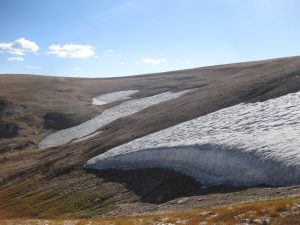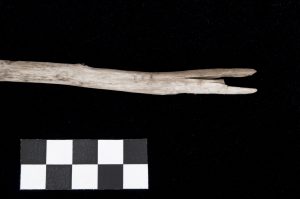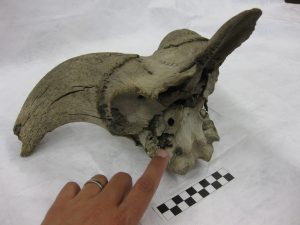Article originally published in the Billings Gazette, May 18, 2017;
Highland Americans: Archaeologist Uncovering Ancient Peoples’ Widespread Use of Mountains;
A small group of archaeologists are blazing a path into places like Wyoming’s Wind River Range, the Tetons and Montana’s Beartooth Plateau, rewriting the understanding of prehistoric people’s use of what are now high elevation wilderness areas. “We really need to be thinking about the Rocky Mountains in a way that we haven’t been thinking about them,” said Bonnie Pitblado, an anthropological archaeology professor at the University of Oklahoma. “By Clovis time (about 13,500 years ago), we have clear, clear evidence people are in the New World and they are in the Rocky Mountains and know them intimately,” she added.
Conference
Pitblado was one of 11 researchers gathered at the Buffalo Bill Center of the West earlier this month to speak at a conference of scientists who share an interest in high altitude archaeology. Their work is shedding light on what had long been a dark spot for investigation of prehistoric sites in North America. What they are documenting – from stone tools and arrow points to soapstone bowls and woven cordage and basketry, to large campsites, animal traps and even bison jumps – are forcing academics to rethink long-held theories – namely that the high country was too inhospitable to be inhabited. “You need to change the way you think,” said Todd Guenther, professor of history and archaeology at Central Wyoming College in Riverton, Wyoming.
Guenther’s study of a bison jump found at an elevation of about 10,500 feet, which he said has received “a lot of push back,” is not inconceivable given other cultures’ activities at high elevations. “My dad’s family came from the highest places in Norway,” he said, a harsh, extremely cold climate where hunters survived by following migratory reindeer herds. Why couldn’t early Americans have lived similarly? “If you had food stored up, it’s not a scary thing. It’s just being outdoors,” he said.
An 1821 journal entry by Jacob Fowler noted that early Americans may have been more adapted to the cold, so why not their ancestors? While camped along the Arkansas River in Colorado in late November Fowler saw “…the Indian Children from toddlers to tall boys are out on the Ice by day light, and all as naked as they came into the World.”
Mountain people
Pitblado noted that a DNA analysis performed on the remains of what’s known as the Anzick child, found in Montana’s Shields Valley in 1968, ties early Americans and their ancestors to residents of eastern Russia and Mongolia who also lived at high elevations. “They were happy in the mountains,” she said. Based on the genetic findings, Pitblado said, “We have all of the evidence in the world … that those progenitors of Clovis were mountain people.”
The scientists are also finding that the high country wasn’t the same as we now see it. Old whitebark pine stumps have been dated to 1,100 to 2,100 years ago in places that are now 500 feet above where trees are growing now, Guenther said. “These were happy, well-fed whitebark pine,” he said. That points to the possibility that the high country was warmer for a period of time, maybe encouraging occupation when lower elevations were stricken with drought.

Craig Lee (at left), archaeologist with INSTAAR, and Staffan Peterson, archaeologist with Yellowstone National Park, pause and smile for the camera after a three-day hike into an area of ice patches. Photo: Patrick Gilroy/INSTAAR/YELL
Research
So far, research of these mountain archaeological sites has been minimal, partly because the work only started about two decades ago, but also because the area to cover is so vast and difficult to reach.
Larry Todd, archaeology professor emeritus at Colorado State University, has conducted surveys in the Absaroka Mountains of Wyoming since 2002. In 15 field seasons his team had permission to explore about 650,000 acres of the Shoshone National Forest that agency officials believed was barren of artifacts. “When we talked to the Forest Service they said, ‘Knock yourself out because there’s nothing there,’” Todd said. Although Todd and his crews explored only about 1 percent of that large swath of country, they recorded more than 175,000 prehistoric artifacts. “That sounds like a lot but I want you to take this with a grain of salt,” Todd said, since the entire project area is only 3 percent of the much larger Greater Yellowstone Ecosystem.
Challenges
Another factor that limits research is the remoteness of the region. “It’s physically demanding and logistically complex,” Todd said. Researchers have to backpack and have horses haul in their gear and food to elevations that may be 11,000 feet above sea level where they will camp out and work for 20 days. That points to how well-equipped and knowledgeable early Americans were about living in these same areas. They knew what they were doing, Todd said. Getting people and gear into the mountains isn’t cheap. A typical summer in the Absarokas may cost about $20,000, Todd added, noting that the expense of high elevation archaeology is another logistical problem. That cost doesn’t include any testing of artifacts that may be needed, with those costing anywhere from $300 to $700 apiece.
Threatened

A cluster of Beartooth-area ice patches. The stable ice in these features exhibits little internal deformation or movement (such as occurs in glaciers), and consequently, they can preserve otherwise perishable materials for millennia. Photo: Craig Lee/INSTAAR
Even though their research has been limited, what Todd and his colleagues have documented in the mountains has been impressive, yet he’s concerned. “The record up there is remarkable and under remarkable threat,” he said. Wildland fires are burning more frequently, intensely and larger than at any time in recent history. On one hand wildland fires can make it easier to see some artifacts while destroying others, such as wickiups – small shelters made of wood. A warming climate is also melting mountain ice patches that, as they recede, are revealing spectacular organic artifacts, including arrow shafts, bighorn sheep skulls and baskets. Since ice patches don’t move like glaciers, they are repositories of some of the most impressive recent finds. “The thing that is fun or exciting about it is you get to see nonhunting technology,” said Craig Lee, a research scientist at the Institute of Arctic and Alpine Research. The problem is the ice patches are receding so fast that researchers can’t reach them all in time to find and record 10,000-year-old artifacts before they are destroyed.

Detail of 10,300-year-old foreshaft showing ownership marks. Photo: Tara L. Hornung/INSTAAR

Conical base of a foreshaft. Conical bases allow for the foreshaft to be quickly detached from the main shaft so that it stays embedded in the target and can potentially allow the hunter to reuse the main shaft. The organic elements illustrate the entwined concepts of reliability and maintainability.
A new wilderness
So researchers are hurrying to document as much as they can as quickly as possible. What they’ve revealed so far is changing some long-held archaeological beliefs. “This volume of activity in the alpine area speaks to a long-term symbiotic relationship between humans and their environment,” Lee said. Lee pointed to the irony that wilderness areas, which are largely free of humans and development, are now revealing extensive human occupation for thousands of years. The 1964 Wilderness Act was meant to preserve places “where the earth and its community of life are untrammeled by man, where man himself is a visitor who does not remain.”“Wilderness preserves the best evidence for trammeling around,” Lee said, a place populated by humans, perhaps year round, living off a “seasonally enriched biome.”

Bighorn sheep cluster on an ice patch. Photo: Rachel Reckin Cambridge/GRSLE
Wilderness is also a place where humans are encouraged to “leave no trace,” such as campfire rings or even where they pitched their tent. Yet ancient humans left thousands of artifacts scattered across the landscape along with numerous lodge pads – the sites where they camped. “The density of human occupation is incredible,” Guenther said. “So there’s a lot of cool stuff to be found at high altitudes,” said Robert Kelly, a professor of anthropology at the University of Wyoming. “And let’s face it, it’s a cool place to work.”
But there are still so many questions yet to be answered, such as why did use of high elevations seem to rise and fall? Was the cause drought or overpopulation? “Why (did they) go up there?” he asked. “We don’t know the answer.” The scientists do know one thing, though. “So the take-home message is … it’s been pretty silly for us to not have thought about the importance of mountains” to ancient people, Pitblado said. “We have all of the evidence in the world that those progenitors of Clovis were mountain people.”
It’s the science, and a lot more
Scientists are using some pretty incredible modern tools to learn more about ancient artifacts and the people who made and used them. Take Matt Stirn for example, a co-director of archaeological research at the Jackson Hole Historical Society and Museum. He’s had residue from the inside of ancient pots uncovered in Wyoming’s Wind River Mountains analyzed to find out what folks were eating. The results are not too surprising, since the ingredients were all locally sourced, including: trout, roots, berries, seeds, nuts, marmot and possibly bison, elk or deer meat. One grinding stone also revealed the first evidence of whitebark pine seed processing.The diet closely resembles what’s been recorded by earlier archaeologists as the diet of people known as the Mountain Shoshone or Sheepeaters, nomadic bands that lived in the high mountains of what is now Montana, Wyoming and Idaho.The analysis is based on absorbed lipid residues. Lipids are fatty acids that don’t dissolve in water. The tests were conducted by Mary Malainey from Brandon University in Canada. Similar tests on artifacts in museum collections have also been done.

Complete bighorn sheep (Ovis Canadensis) skull from a GYA ice patch. Photo: Craig Lee/INSTAAR
“It’s an amazing opportunity for older artifacts to have a new life,” Stirn said. The information is valuable because remnants of what humans may have been eating are typically destroyed by nature over time, leaving no trace. Using factors at the campsites that researchers had found, Stirn was also able to develop a computer model to find other places with similar features that could help scientists locate even more sites.
Paul Burnett of SWCA Environmental Consultants in Fort Collins, Colorado, developed a similar “archaeology probability model” for the Shoshone National Forest that he’s been tweaking. He’s been driven by the massive forest fires sweeping the West and destroying artifacts before researchers have a chance to record them. “It provides a tool to focus our strategies,” he said.
Scientists are also analyzing burial sites in South America’s high Andes Mountains to figure out whether ancient people were using the high elevations there seasonally, or year-round. Randy Haas, a postdoctoral researcher at the University of Wyoming Department of Anthropology, excavated a Paleo-Indian settlement in 2014 that made a case for permanent occupation at high elevations as far back as 11,000 years ago in the south-central Andes. More than 80,000 artifacts were recovered, much of it flaked local stone, but what really sealed the deal was an analysis of oxygen isotopes in human bones recovered at the site. The isotopes revealed that all 16 of the remains found were from humans who were probably living at high elevations. The humans weren’t just men on hunting trips, either. The bones included five males, eight females, two children and three that were indeterminate. The high plains of South America are “not too much different than around here – high plains flanked by high mountains,” Haas said. “The ecological niche is similar … and the archaeological record looks very similar to what you would find here.”
A new 9 minute video on “Ice Patch Archaeology” in the Greater Yellowstone can be found here:
Description: Archaeological resources emerging from retreating ice patches can capture public interest and integrate education about archaeology and Native American cultures with ancient and modern climate change. This new video provides an overview of archaeological materials found in ice patches in the Greater Yellowstone region and the effects of climate change on them. This work began in 2005 with support from the USDA Forest Service’s Custer-Gallatin National Forest Heritage Program and the Region 1 Heritage Stewardship Enhancement (HSE) Program, and the video was made by Montana PBS and the Institute of Arctic and Alpine Research (INSTAAR) with support from the HSE Program. The target audience includes all of the citizens of Montana, but it will be of interest to all of the citizens of the Greater Yellowstone Ecosystem / Greater Yellowstone Area (Montana, Idaho, Wyoming) as well as to people living elsewhere in the Rocky Mountains or other areas with alpine snow and ice in North America and around the world.
